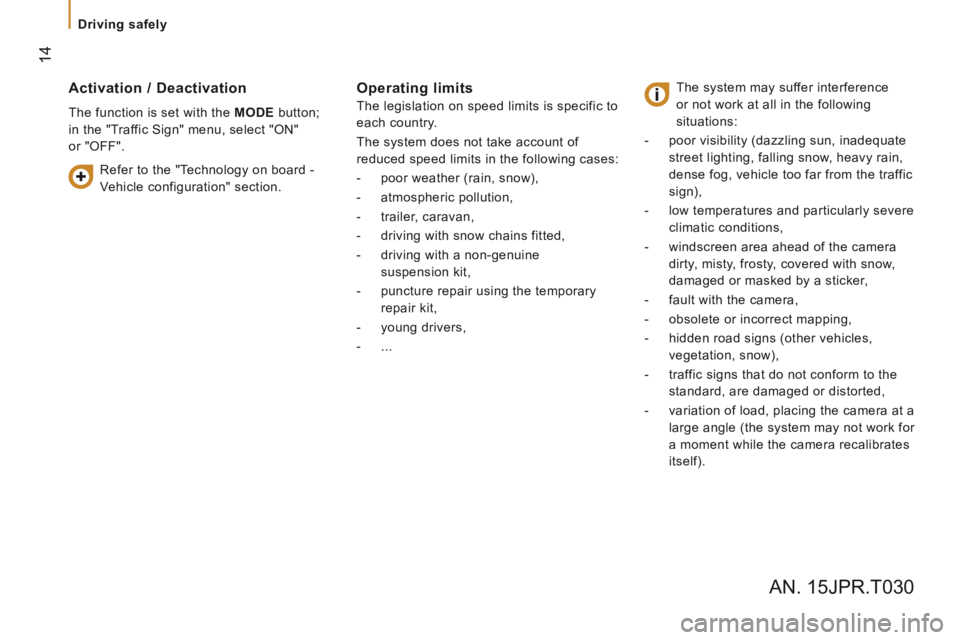Page 261 of 308
259
● Ensure that there is no person or obstacle nearby (below or
above) when unloading.
●
Never leave the tipper body raised when not in use.
●
Always discharge the load with the top part of the rear body si
de
secured.
●
Observe the maximum payload on the weights plate on the
vehicle.
●
Check regularly that the suspension is in good condition and
that the tyres are inflated to the recommended pressures.
●
Distribute the load uniformly in the tipper body
.
●
T
ransport similar products that discharge easily.
SAFEtY A d VI c E
Discharge onto a flat and hard surface: a sloping
or loose surface may cause a change in the centre
of gravity, with an adverse affect on the stability of
the vehicle.
●
Never drive, even slowly
, with the tipper body raised.
SPECIAL FEATURES
Tipper body
Page 275 of 308

06.15
We draw your attention to the following points:
- The fitting of electrical equipment or accessories not
listed by CITROËN may cause faults and failures with
the electrical system of your vehicle. Contact a CITROËN
dealer for information on the range of recommended
accessories.
-
As a safety measure, access to the diagnostic socket,
used for the vehicle's electronic systems, is reserved
strictly for CITROËN dealers or qualified workshops,
equipped with the special diagnostic tool required (risk of
malfunctions of the vehicle's electronic systems that could
cause breakdowns or serious accidents).
The manufacturer
cannot be held responsible if this advice is not followed.
-
Any modification or adaptation not intended or authorised
by
Automobiles CITROËN or carried out without meeting
the technical requirements defined by the manufacturer
would lead to the suspension of the legal and contractual
warranties.
Labels are applied at various points on your vehicle. They
carry safety warnings as well as vehicle identification
information. Do not remove them: they form an integral
part of your vehicle.
Automobiles CITROËN
declares, by application of the
provisions of the European legislation (Directive
2000/53)
relating to End of Life Vehicles, that it achieves the
objectives set by this legislation and that recycled
materials are used in the manufacture of the products that
it sells. Reproduction or translation of all or part of this document
is prohibited without written authorisation from Automobiles
CITROËN. Printed in the EU
Anglais
The descriptions and illustrations are given without any
obligation. Automobiles CITROËN reserves the right
to modify the technical specifications, equipment and
accessories without having to update this edition of the
handbook.
This document is an integral part of your vehicle. It should
be passed on to the new user in the event of sale or
transfer.
Page 292 of 308

14
Driving safely
Activation / Deactivation
The function is set with the MODE button;
in the "Traffic Sign" menu, select "ON"
or "OFF".
Operating limits
The legislation on speed limits is specific to
each country.
The system does not take account of
reduced speed limits in the following cases:
- poor weather (rain, snow),
- atmospheric pollution,
- trailer, caravan,
- driving with snow chains fitted,
- driving with a non-genuine
suspension kit,
- puncture repair using the temporary
repair kit,
- young drivers,
- ...
The system may suffer interference
or not work at all in the following
situations:
- poor visibility (dazzling sun, inadequate
street lighting, falling snow, heavy rain,
dense fog, vehicle too far from the traffic
sign),
- low temperatures and particularly severe
climatic conditions,
- windscreen area ahead of the camera
dirty, misty, frosty, covered with snow,
damaged or masked by a sticker,
- fault with the camera,
- obsolete or incorrect mapping,
- hidden road signs (other vehicles,
vegetation, snow),
- traffic signs that do not conform to the
standard, are damaged or distorted,
- variation of load, placing the camera at a
large angle (the system may not work for
a moment while the camera recalibrates
itself).
Refer to the "Technology on board -
Vehicle configuration" section.
AN. 15JPR.T030
Page 308 of 308

14
Driving safely
Activation / Deactivation
The function is set with the MODE button;
in the "Traffic Sign" menu, select "ON"
or "OFF".
Operating limits
The legislation on speed limits is specific to
each country.
The system does not take account of
reduced speed limits in the following cases:
- poor weather (rain, snow),
- atmospheric pollution,
- trailer, caravan,
- driving with snow chains fitted,
- driving with a non-genuine
suspension kit,
- puncture repair using the temporary
repair kit,
- young drivers,
- ...
The system may suffer interference
or not work at all in the following
situations:
- poor visibility (dazzling sun, inadequate
street lighting, falling snow, heavy rain,
dense fog, vehicle too far from the traffic
sign),
- low temperatures and particularly severe
climatic conditions,
- windscreen area ahead of the camera
dirty, misty, frosty, covered with snow,
damaged or masked by a sticker,
- fault with the camera,
- obsolete or incorrect mapping,
- hidden road signs (other vehicles,
vegetation, snow),
- traffic signs that do not conform to the
standard, are damaged or distorted,
- variation of load, placing the camera at a
large angle (the system may not work for
a moment while the camera recalibrates
itself).
Refer to the "Technology on board -
Vehicle configuration" section.
AN. 15JPR.T030